Culture of Malaysia
The Malay are
Malaysia's largest ethnic group, accounting for over half the
population and the
 national language. With the oldest
indigenous peoples they form a group called bumiputera, which
translates as "sons" or "princes of the
soil." Almost all Malays are Muslims, though Islam here is
less extreme than in the Middle East. Traditional Malay culture
centers around the kampung, or village, though today one is just
as likely to find Malays in the cities.
national language. With the oldest
indigenous peoples they form a group called bumiputera, which
translates as "sons" or "princes of the
soil." Almost all Malays are Muslims, though Islam here is
less extreme than in the Middle East. Traditional Malay culture
centers around the kampung, or village, though today one is just
as likely to find Malays in the cities.
The Chinese traded
with Malaysia for centuries, then settled in number during the
19th century when word of riches in the Nanyang, or "South
Seas," spread across China. Though perhaps a stereotype, the
Chinese are regarded as Malaysia's businessmen, having succeeded
in many industries. When they first arrived, however, Chinese
often worked the most grueling jobs like tin mining and railway
construction. Most Chinese are Tao Buddhist and retain strong
ties to their ancestral homeland. They form about 35 percent of
the population.
Indians had been
visiting Malaysia for over 2,000 years, but did not settle en
masse until the 19th century. Most came from South India, fleeing
a poor economy. Arriving in Malaysia, many worked as rubber
tappers, while others built the infrastructure or worked as
administrators and small businessmen. Today ten percent of
Malaysia is Indian. Their culture -- with it's exquisite Hindu
temples, cuisine, and colorful garments -- is visible throughout
the land.
The oldest
inhabitants of Malaysia are its tribal peoples. They account for
about 5 percent of the total population, and represent a majority
in Sarawak and Sabah. Though Malaysia's tribal people prefer to
be categorized by their individual tribes, peninsular Malaysia
blankets them under the term Orang Asli, or "Original
People." In Sarawak, the dominant tribal groups are the
Dayak, who typically live in longhouses and are either Iban (Sea Dayak) or
Bidayuh (land Dayak). In Sabah, most tribes fall under the term
Kadazan. All of Malaysia's tribal people generally share a strong
spiritual tie to the rain forest
Cultures have been meeting and
mixing in Malaysia since the very beginning of its history.More
thanfifteen hundred years ago a Malay kingdom in Bujang Valley
welcomed traders from China and India. With the arrival of gold
and silks, Buddhism and Hinduism also came to Malaysia. A
thousand years later, Arab traders arrived in Malacca and brought
with them the principles and practices of Islam. By the time the
Portuguese arrived in Malaysia, the empire that they encountered
was more cosmopolitan than their own.
Malaysia's cultural mosaic is marked by many
different cultures, but several in particular have had especially
lasting influence on the country. Chief among these is the
ancient Malay culture, and the cultures of Malaysia's two most
prominent trading partners throughout history--the Chinese, and
the Indians. These three groups are joined by a dizzying array of
indigenous tribes, many of which live in the forests and coastal
areas of Borneo. Although each of these cultures has vigorously
maintained its traditions and community structures, they have
also blended together to create contemporary Malaysia's uniquely
diverse heritage.
One example of the complexity with which
Malaysia's immigrant populations have contributed to the nation's
culture as a whole is the history of Chinese immigrants. The
first Chinese to settle in the straits, primarily in and around
Malacca, gradually adopted elements of Malaysian culture and
intermarried with the Malaysian community. Known as babas and
nonyas, they eventually produced a synthetic set of practices,
beliefs, and arts, combining Malay and Chinese traditions in such
a way as to create a new culture. Later Chinese, coming to
exploit the tin and rubber booms, have preserved their culture
much more meticulously. A city like Penang, for example, can
often give one the impression of being in China rather than in
Malaysia.
Another example of Malaysia's extraordinary
cultural exchange the Malay wedding ceremony, which incorporates
elements of the Hindu traditions of southern India; the bride and
groom dress in gorgeous brocades, sit in state, and feed each
other yellow rice with hands painted with henna. Muslims have
adapted the Chinese custom of giving little red packets of money
(ang pau) at festivals to their own needs; the packets given on
Muslim holidays are green and have Arab writing on them.
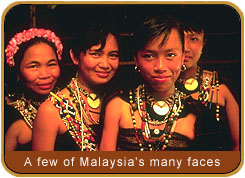
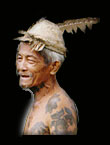
You can go from a Malaysian
kampung to a rubber plantation worked by Indians to Penang's
Chinese kongsi and feel you've traveled through three nations.
But in cities like Kuala Lumpur, you'll find everyone in a grand
melange. In one house, a Chinese opera will be playing on the
radio; in another they're preparing for Muslim prayers; in the
next, the daughter of the household readies herself for classical
Indian dance lessons.
Perhaps the easiest way to begin
to understand the highly complex cultural interaction which is
Malaysia is to look at the open door policy maintained during
religious festivals. Although Malaysia's different cultural
traditions are frequently maintained by seemingly self-contained
ethnic communities, all of Malaysia's communities open their
doors to members of other cultures during a religious
festival--to tourists as well as neighbors. Such inclusiveness is
more than just a way to break down cultural barriers and foster
understanding. It is a positive celebration of a tradition of
tolerance that has for millennia formed the basis of Malaysia's
progress.
Back to Top
Music & Dance in Malaysia
Music and dance are almost inseparable in the
Malaysian culture. Where there is one, the other is not far
behind. True to Malaysia's heritage, dances vary widely and are,
if not imports direct from the source nation, heavily influenced
by one or more of Malaysia's cultural components. Much of
Malaysian music and dance has evolved from more basic needs into
the mesmerizing, complex art forms they are today.
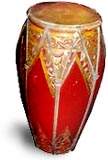
Traditional music is centered around the
gamelan, a stringed instrument from Indonesia with an
otherworldly, muffled sound. The lilting, hypnotic beats of
Malaysian drums accompany the song of the gamelan; these are
often the background for court dances. Malaysia's earliest
rhythms were born of necessity. In an age before phone and fax,
the rebana ubi, or giant drums, were used to communicate from
hill to hill across vast distances. Wedding announcements, danger
warnings, and other newsworthy items were drummed out using
different beats. The rebana ubi are now used primarily as
ceremonial instruments. The Giant Drum Festival is held in
Kelantan either in May or June.
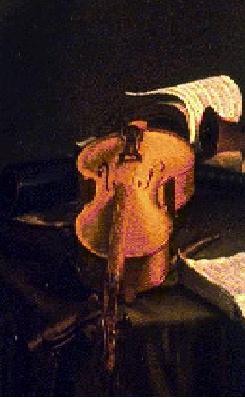
Dikir barat is a style of call and response
singing originating in Kelantan (Malm 1974). It is well known
throughout the Peninsular through local television and performing
groups. A dikir barat group, which may be of any size, is led by
a tukang karut who makes up poems and sings them as he goes
along. The chorus echoes in response, verse by verse. Dikir barat
groups usually perform during various festive occassions, and
their poems are usually light entertainment and may be about any
topic, but are not religious in nature. The chorus traditionally
consists of all men, but modern groups, especially those
performing on television, often include women. Traditionally, no
musical instruments are used, the singing being accompanied
instead by rhythmic clapping and energetic body movements. Some
groups however do use a pair of frame drums or rebana, a shallow
gong and a pair of maracas, for accompaniment. (Aziz & Wan
Ramli 1994).
Mak Yong is an
ancient dance-theatre form incorporating the elements of ritual,
stylized dance and acting, vocal and instrumental music, story,
song, formal as well as improvised spoken text.It is performed
principally in the state of Kelantan, Malaysia. Many theories
have been advanced to explain the genre's origins. Its roots
obviously sink deep into animism as well as shamanism.
Briefly early in the present century, an
unsuccessful attempt was made in Kelantan to create a palace
version of mak yong. The mak yong orchestra is made up of a
three-stringed spiked fiddle (rebab), a pair of double-headed
barrel drums(gendang) and a pair of hanging knobbed
gongs(tetawak) while the genre's musical repertoire consists of
approximately thirty pieces, most of them accompanied by singing
and dancing. No stage-properties and few simple hand-properties
are used.
In mak yong, the male lead role (pak
yong) is conventionally played by female performers. In addition
there are the following roles: the female lead (mak yong); a pair
of clowns (peran), a pair of female attendants (inang) as well as
a wide range of lesser roles including those of gods and spirits,
orges or giants, palace functionaries and animals.
The mak yong repertoire consists of a
dozen or so stories, still existing in the oral tradition,
dealing with the adventures of gods or mythical kings. The
principal, and earliest story in the mak yong repertoire,
entitled Dewa Muda, has tremendous spiritual significance. Mak
yong performances last between about 9.00 p.m and midnight, and a
story is generally completed in several nights.
Similarly, silat, an elegant
Malaysian dance form, originated as a deadly martial art. The
weaponless form of self-defense stripped fighting to a bare
minimum. Silat displays are common at weddings and other
festivals; the dancer will perform sparring and beautiful
routines to accompanying drums and other musical instruments.
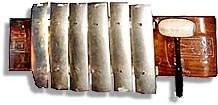
The candle dance is one of
Malaysia's most breathtakingly beautiful performance arts.
Candles on small plates are held in each hand as the dancer
performs. As the performer's body describes graceful curves and
arcs, the delicate candle flames become hypnotic traces.
The Joget, Malaysia's most popular traditional
dance, is a lively dance with an upbeat tempo. Performed by
couples who combine fast, graceful movements with rollicking good
humor, the Joget has its origins in the Portuguese folk dance,
which was introduced to Malacca during the era of the spice
trade.
Among the many different traditional theatres
of the Malays, which combine dance, drama, and music, no other
dance drama has a more captivating appeal than Mak Yong. This
ancient classic court entertainment combines romantic stories,
operatic singing and humor.
The Datun Julud is a popular dance of Sarawak,
and illustrates the age-old tradition of storytelling in dance.
The Datun Jalud tells of the happiness of a prince when blessed
with a grandson. It was from this divine blessing that the dance
became widespread among the Kenyah tribe of Sarawak. The Sape, a
musical instrument, renders the dance beats, which are often
helped along by singing and clapping of hands.
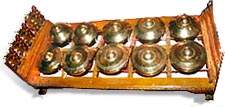 Although
Malaysia's cultural heritage is rich and varied almost beyond
belief, it would be a mistake to assume that heritage to be
wholly traditional. Malaysia has joined the recent world music
trend by updating many of its beautiful traditional sounds.
Modern synthesizers accompany the gamelan and the drums for a
danceable, hypnotic sound you won't soon forget.
Although
Malaysia's cultural heritage is rich and varied almost beyond
belief, it would be a mistake to assume that heritage to be
wholly traditional. Malaysia has joined the recent world music
trend by updating many of its beautiful traditional sounds.
Modern synthesizers accompany the gamelan and the drums for a
danceable, hypnotic sound you won't soon forget.
Back to Top
Art and Architecture
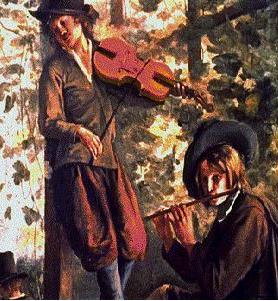
Malaysian decorative art forms include colorful
batik cloth, silverware, pewter items, and woodcarvings. Like
other elements of Malaysian culture, its architecture reflects
influences from India, China, and Islam. These influences are
most pronounced in religious structures. The British introduced
colonial architecture and, in buildings such as the old post
office and railway station in Kuala Lumpur, the Moorish style.
Music, Dance, and Drama.
Hindu, Islamic, and Indonesian forms influenced
music in Malaysia. For example, wayang kulit (shadow-puppet
theater), was introduced from Java in the 13th century, and today
is most commonly found in the state of Kelantan. Malaysian
musical instruments include distinctive drums (gendang), of which
there are at least 14 types; gongs and other percussion
instruments made from native materials such as bamboo (kertuk and
pertuang) and coconut shells (raurau); and a variety of wind
instruments, including flutes. Ensembles (nobat) and orchestras
(gamelan) play these instruments at special occasions. Chinese
musical forms, including Chinese opera, were more recently
introduced into Malaysia; however, today's young Malaysians of
Chinese descent have little interest in such forms of music.
Back to Top
Theatre
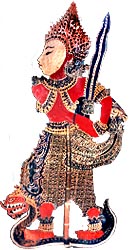
|
Perhaps the best known Malaysian
theater event is the wayang kulit. Before the
encroachment of television, the wayang kulit, or shadow
puppet play, was the favorite after-dark entertainment.
The enang, as the puppeteer was called, directed the
puppets' intricate movements while singing dozens of
parts in a performance which often lasted several hours.
The wayang kulit draws its inspiration from the Ramayana,
the Hindi epic comprised of a potpourri of immortal
tales. The wayang kulit throws in a handful of Javanese
and Malay characters for good measure and then pits good
against evil in a classic plot. Warrior animals, giants,
ghouls, princes, and priests battle it out to the finish
in this rousing epic. |
Back to Top
Games & Pastimes
In a world where nature provided for many of humankind's
needs, leisure was honed to an art form. Much of Malaysian
leisure time is occupied by elaborate competitions. Kite-flying
is a favorite among participants and spectators alike.  Kites, called waus, are painstakingly
designed and crafted in vibrant colors and patterns. Intricate
floral cutouts are pasted on, building up the design until the
kite is ready for the bright paper tassels that complete its
decoration. Kite construction is an ancient art passed down from
the nobles of the Melakan court. Over the dried padi fields, a
wau bulan, or moon kite, catches an upcurrent of air. Its wing
span is larger than that of an albatross. What used to be a
post-harvest diversion among padi farmers has become an
international event. Wau festivals are organized each year and
draw participants from as far away as the Netherlands, Japan,
Germany, Belgium, and Singapore.
Kites, called waus, are painstakingly
designed and crafted in vibrant colors and patterns. Intricate
floral cutouts are pasted on, building up the design until the
kite is ready for the bright paper tassels that complete its
decoration. Kite construction is an ancient art passed down from
the nobles of the Melakan court. Over the dried padi fields, a
wau bulan, or moon kite, catches an upcurrent of air. Its wing
span is larger than that of an albatross. What used to be a
post-harvest diversion among padi farmers has become an
international event. Wau festivals are organized each year and
draw participants from as far away as the Netherlands, Japan,
Germany, Belgium, and Singapore.
The pre-harvest counterpart to the post-harvest wau-flying is
top-spinning, a game requiring great strength, excellent timing,
and dexterity. These are not childrens' toys. A gasing, or
spinning top, can weigh up to ten pounds and can sometimes be as
large as a dinner plate. Gasing competitions are judged by the
length of time each top spins. The tops are set spinning by
unfurling a rope that has been wound about the top. A gasing
expert can set one spinning for over an hour.
Silat is at once a fascinating, weaponless Malay art of self
defense and also a dance form that has existed in the Malay
Archipelago for hundreds of years. Like the best martial arts,
silat is often more about the spirit than the body. The silat
practitioner also develops spiritual strength, according to the
tenets of Islam.
In an age when many of the martial arts are dying out, young
people are especially drawn to this art--there are countless
silat groups in Malaysia, each with their own style. Silat
demonstrations are held during weddings, national celebrations,
and of course during silat competitions.
Sepak Takraw is one of Malaysia's most popular sports. In a
game reminiscent of hackey-sack (or perhaps the source for it),
players use heels, soles, in-steps, thighs, shoulders and
heads--everything but hands--to keep the small rattan ball aloft.
Back to Top
Crafts
Batik
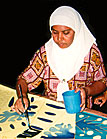
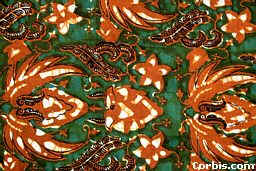
Hindu traders
first brought batik to Malaysia eons ago, and the art of dying
fabric has been an established tradition for centuries. Designs
are first sketched out on cloth, then blocked off with wax
outlines. They are then painted and later sealed with TK.
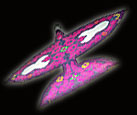 Kite Making
Kite Making
Kites, called
waus, are painstakingly designed and crafted in vibrant colors
and patterns. Intricate floral cutouts are pasted on, building up
the design until the kite is ready for the bright paper tassels
that complete its decoration. Kite construction is an ancient art
passed down from the nobles of the Melakan court
Pewter Making
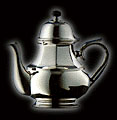 Having the world's largest reserves of tin, it
seems appropriate enough that Malaysia also produces what is
widely regarded as the world's finest pewter. Most of it is
produced at the Royal Selangor Pewter Factory, which lies
just outside of Kuala Lumpur. The factory was founded in 1885 by
Yoon Koon, a Chinese artisan who crafted objects only for the
aristocracy. Today Royal Selangor is the largest single
manufacturer of fine pewter in the world, and and it is still run
by Koon's third-generation descendants. The factory gives a full
tour of the production floor, and visitors to the gift shop have
the privilege of buying any of the items duty-free.
Having the world's largest reserves of tin, it
seems appropriate enough that Malaysia also produces what is
widely regarded as the world's finest pewter. Most of it is
produced at the Royal Selangor Pewter Factory, which lies
just outside of Kuala Lumpur. The factory was founded in 1885 by
Yoon Koon, a Chinese artisan who crafted objects only for the
aristocracy. Today Royal Selangor is the largest single
manufacturer of fine pewter in the world, and and it is still run
by Koon's third-generation descendants. The factory gives a full
tour of the production floor, and visitors to the gift shop have
the privilege of buying any of the items duty-free.
Weaving
 The jungle provides an abundance of ideal
materials for Malaysia's many types of weaving. The thorny vines
of the rattan tree, for example, are worked and woven into
comfortable chairs and tables -- unique furniture that was so
popular with the English that it could be seen in the parlors of
just about every British resident. The strong and versatile
fronds of the sago palm are also superbly suited for crafting. In
Borneo, the sago is dyed and woven into beautiful and distinctly
patterned jewelry, baskets, hats, floor mats, and more.
The jungle provides an abundance of ideal
materials for Malaysia's many types of weaving. The thorny vines
of the rattan tree, for example, are worked and woven into
comfortable chairs and tables -- unique furniture that was so
popular with the English that it could be seen in the parlors of
just about every British resident. The strong and versatile
fronds of the sago palm are also superbly suited for crafting. In
Borneo, the sago is dyed and woven into beautiful and distinctly
patterned jewelry, baskets, hats, floor mats, and more.
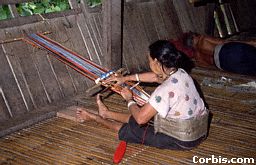
Iban Woman Weaver, Sarawak
A woman weaves using
traditional techniques at Kampong Budaya in Sarawak. The village
has been declared a Cultural Village since 1990 to protect the
skills and customs of the Iban population. Malaysia.
Wood Carving
On both the
peninsula and in Borneo, wood carving reaches an astounding level
of intricacy. What is truly special about this art form in
Malaysia is that all of her cultures have perfected it. You see
it everywhere: in the delightful porticos of Malay houses, in the
roofs and altars Chinese and Hindu temples, on the prows of
colorful fishing boats, and in the burial poles and masks of
Sarawak.

A
kris is can only be made by an empu, a revered
artisan who is also endowed with magical powers.
Once an empu selects a day to begin the task, he fasts and prays,
warding off evil spirits and wining the favors of the demit,
or good genies.
To forge a kris blade, the empu
alternates one layer of steel with two layers of special iron
extracted from a meteorite. This is necessary for the pamor,
or silvery marbling of the blade. The layers are forged together
and flattened. To obtain a particular pamor, the empu twists the
two halves of the steel bar separately. This is repeated as many
times it takes to get the desired effect. The sequence of
layering, bending, beating and forging forms a number of layers.
Generally, a good kris has 64 layers of iron and pamor. It is
said that some have thousands.
The blade is forged into its final
shape, straight or curved, then given ribbing and tang. Using
very fine files, grindstones, and chisels, the ribbing is
heightened, relief created on the blade, and the ricikan
(the characteristic teeth or projections on a kris) is chiseled.
Finally, the emput makes the ganja, or base, and tempers the
blade by bringing it to red hot and immersing it rapidly in
coconut oil.
The entire process can take
months, partly because the empu will only work on days that he
considers favorable. The blade is considered incomplete until it
is merged with the handle and the sheath, and the owner has made
offerings and contacted the spirit of the kris by dream.
Back to Top
Myths & Legends
To the orang asli, the "original people" who have
for millenia inhabited the forests of Malaysia, the earth was an
abode for more than the diversity of plant and animal life. The
world's oldest jungles, dense with mystery, were the playground
of spirits, both benevolent and, well, less so.
Prominent natural features--and there are many in
Malaysia--were wreathed in legend. Tioman Island is said to have
been a dragon princess who decided to make her home where Tioman
now rises out of the sea. Tranquil Lake Chini in the wilds of
Pahang is thought to be the site of a magnificent Khmer city now
sunk beneath the lotus blossoms. Mount Ophir, in Johor, is said
to be the home of 'Puteri Gunung Ledang', a legendary princess
once wooed by the Sultan of Malacca. The princess' beauty is
still associated with the natural charms of the mountain itself.
Langkawi Island has no such creation story, but the curse laid on
the island by a princess falsely accused of adultery is one of
the best-known of Malaysia's magical myths.
The supernatural imbues not only the land and water, but
living things as well. The orang asli believe that one's
semangat--soul or life force--traveled abroad during sleep;
dreams were the record of the soul's adventures. In the city, it
is a little harder to find someone who believes so wholeheartedly
in what was once a compelling way of thought. But fragments of
the old mythological system remain; the kris--the wavy-bladed
Malay dagger--is a shining example. Many Malays have their own
kris as well as their own kris tales. The kris is reputed to be
able to fly by night and seek out victims (their owners' enemies,
presumably) without a guiding hand. One who possessed a loyal
kris was indeed powerful.
 "The kris
is reputed to be able to fly by night and seek out victims (their
owners' enemies, presumably) without a guiding hand. One who
possessed a loyal kris was indeed powerful."
"The kris
is reputed to be able to fly by night and seek out victims (their
owners' enemies, presumably) without a guiding hand. One who
possessed a loyal kris was indeed powerful."
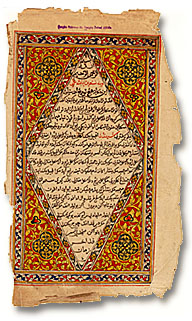
The manuscript above relates the story of Hang
Tuah, the most revered warrior of the Malaccan Sultanate. The
Sultan Tun Perak ordered Tuah to be executed after he offended
the sultan, but a loyal bendahara (royal advisor) secretly
imprisoned him instead. Courtiers later discovered Tuah's best
friend, Hang Kasturi, romancing one of the sultan's concubines,
and surrounded the palace - but no one dared go in to capture
Kasturi. When the sultan was told that Tuah was still alive, he
ordered Tuah to kill his best friend to prove his loyalty. During
the fight, Tuah embedded his kris in the palace wall three times,
but Kasturi allowed him to remove it. But when the same thing
happened to Kasturi, Tuah stabbed him in the back."Does a
man who is a man go back on his word like that," asked a
dying Kasturi. "Who need play fair with you, you who have
been guilty of treason," Tuah replied. The sultan rewarded
him with the title laksamana, or admiral.
Back to Top
 States
States
 Tourism
Tourism
 National Symbols
National Symbols
 History
History
 Geography
Geography
 Flora & Fauna
Flora & Fauna
 Economy
Economy
 Culture
Culture
 Festivals
Festivals
 Transportation
Transportation
 Accommodation
Accommodation
 Foreign Exchange
Foreign Exchange
 Food
Food
 Fruits
Fruits
 national language. With the oldest
indigenous peoples they form a group called bumiputera, which
translates as "sons" or "princes of the
soil." Almost all Malays are Muslims, though Islam here is
less extreme than in the Middle East. Traditional Malay culture
centers around the kampung, or village, though today one is just
as likely to find Malays in the cities.
national language. With the oldest
indigenous peoples they form a group called bumiputera, which
translates as "sons" or "princes of the
soil." Almost all Malays are Muslims, though Islam here is
less extreme than in the Middle East. Traditional Malay culture
centers around the kampung, or village, though today one is just
as likely to find Malays in the cities.





 Although
Malaysia's cultural heritage is rich and varied almost beyond
belief, it would be a mistake to assume that heritage to be
wholly traditional. Malaysia has joined the recent world music
trend by updating many of its beautiful traditional sounds.
Modern synthesizers accompany the gamelan and the drums for a
danceable, hypnotic sound you won't soon forget.
Although
Malaysia's cultural heritage is rich and varied almost beyond
belief, it would be a mistake to assume that heritage to be
wholly traditional. Malaysia has joined the recent world music
trend by updating many of its beautiful traditional sounds.
Modern synthesizers accompany the gamelan and the drums for a
danceable, hypnotic sound you won't soon forget.


 Kites, called waus, are painstakingly
designed and crafted in vibrant colors and patterns. Intricate
floral cutouts are pasted on, building up the design until the
kite is ready for the bright paper tassels that complete its
decoration. Kite construction is an ancient art passed down from
the nobles of the Melakan court. Over the dried padi fields, a
wau bulan, or moon kite, catches an upcurrent of air. Its wing
span is larger than that of an albatross. What used to be a
post-harvest diversion among padi farmers has become an
international event. Wau festivals are organized each year and
draw participants from as far away as the Netherlands, Japan,
Germany, Belgium, and Singapore.
Kites, called waus, are painstakingly
designed and crafted in vibrant colors and patterns. Intricate
floral cutouts are pasted on, building up the design until the
kite is ready for the bright paper tassels that complete its
decoration. Kite construction is an ancient art passed down from
the nobles of the Melakan court. Over the dried padi fields, a
wau bulan, or moon kite, catches an upcurrent of air. Its wing
span is larger than that of an albatross. What used to be a
post-harvest diversion among padi farmers has become an
international event. Wau festivals are organized each year and
draw participants from as far away as the Netherlands, Japan,
Germany, Belgium, and Singapore.


 Kite Making
Kite Making Having the world's largest reserves of tin, it
seems appropriate enough that Malaysia also produces what is
widely regarded as the world's finest pewter. Most of it is
produced at the Royal Selangor Pewter Factory, which lies
just outside of Kuala Lumpur. The factory was founded in 1885 by
Yoon Koon, a Chinese artisan who crafted objects only for the
aristocracy. Today Royal Selangor is the largest single
manufacturer of fine pewter in the world, and and it is still run
by Koon's third-generation descendants. The factory gives a full
tour of the production floor, and visitors to the gift shop have
the privilege of buying any of the items duty-free.
Having the world's largest reserves of tin, it
seems appropriate enough that Malaysia also produces what is
widely regarded as the world's finest pewter. Most of it is
produced at the Royal Selangor Pewter Factory, which lies
just outside of Kuala Lumpur. The factory was founded in 1885 by
Yoon Koon, a Chinese artisan who crafted objects only for the
aristocracy. Today Royal Selangor is the largest single
manufacturer of fine pewter in the world, and and it is still run
by Koon's third-generation descendants. The factory gives a full
tour of the production floor, and visitors to the gift shop have
the privilege of buying any of the items duty-free.
 The jungle provides an abundance of ideal
materials for Malaysia's many types of weaving. The thorny vines
of the rattan tree, for example, are worked and woven into
comfortable chairs and tables -- unique furniture that was so
popular with the English that it could be seen in the parlors of
just about every British resident. The strong and versatile
fronds of the sago palm are also superbly suited for crafting. In
Borneo, the sago is dyed and woven into beautiful and distinctly
patterned jewelry, baskets, hats, floor mats, and more.
The jungle provides an abundance of ideal
materials for Malaysia's many types of weaving. The thorny vines
of the rattan tree, for example, are worked and woven into
comfortable chairs and tables -- unique furniture that was so
popular with the English that it could be seen in the parlors of
just about every British resident. The strong and versatile
fronds of the sago palm are also superbly suited for crafting. In
Borneo, the sago is dyed and woven into beautiful and distinctly
patterned jewelry, baskets, hats, floor mats, and more.

 "The kris
is reputed to be able to fly by night and seek out victims (their
owners' enemies, presumably) without a guiding hand. One who
possessed a loyal kris was indeed powerful."
"The kris
is reputed to be able to fly by night and seek out victims (their
owners' enemies, presumably) without a guiding hand. One who
possessed a loyal kris was indeed powerful."